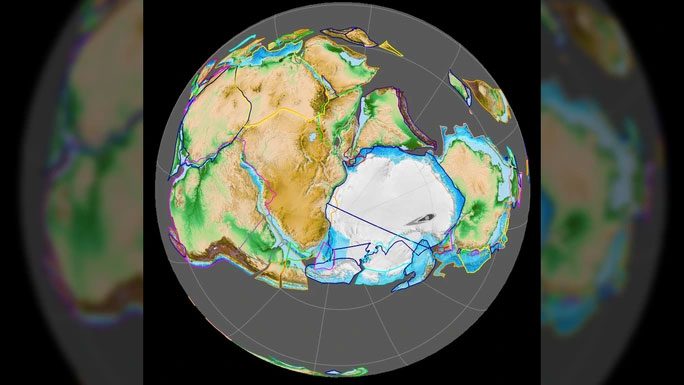The mass extinction event 390 million years ago on the “dead supercontinent” Gondwana has just been unveiled, serving as a chilling warning for modern humanity.
A recent study published in the scientific journal Earth-Science Reviews investigated fossil layers described as “cake-like” and highlighted a terrifying period that lasted for 5 million years on our planet.

The shattered supercontinent Gondwana – (Photo: Fama Clamosa).
Hundreds of millions of years ago, the world was home to two supercontinents: to the north was Laurasia, and to the south was Gondwana.
Gondwana included the lands of Antarctica, South America, Oceania, Africa, as well as the Indian subcontinent and the Arabian Peninsula. This supercontinent formed around 600 million years ago, splitting from the supercontinent Pangea, and began to gradually break apart about 180 million years ago.
Gondwana was home to a diverse array of flora and fauna, among which the most mysterious was the Malvinoxhosan organism population, found in what is now South Africa’s seas, primarily consisting of trilobites, bivalves, some mollusks, and echinoderms.
This population was once incredibly abundant on early Earth but abruptly disappeared around 390-385 million years ago.
According to Live Science, the research team led by evolutionary scientist Cameron Penn-Clarke from the University of Witwatersrand (South Africa) has discovered the reasons behind the harsh conditions that led to the extinction of a large group of organisms on this ancient supercontinent.
They warned that the time period of 390-385 million years ago was a 5 million year “hell” caused by climate change, with striking similarities to the climate crisis we are currently inducing.
By thoroughly analyzing the locations, depths, and geological characteristics of fossil-bearing rocks found in South Africa, corresponding to different ancient periods, the research team observed a decline in fossil numbers during that terrifying 5 million years.
Each layer of fossils corresponded to a minor drop in sea level, but was associated with extremely intense factors related to the mass extinction, as these changes in climate were so severe that these organisms could no longer adapt.
“This study is crucial when considering the biodiversity crisis we face today. It demonstrates the sensitivity of extreme environments and ecosystems to changes in sea level and temperature,” said Dr. Penn-Clarke.
This is not the first study to show that climate change can be powerful enough to trigger extinction events.
Dr. Penn-Clarke cautioned, “Unfortunately, any changes that occur are permanent.”





















































